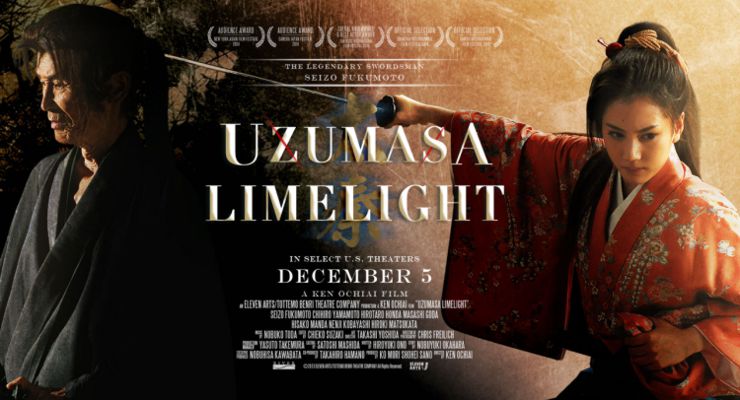Uzumasa (Kyoto) is considered the Hollywood of Japan. It has produced many of the “jidaigeki” films (period dramas with sword fighting) that are loved by many Japanese, and are highly praised all over the world. These films wouldn’t be what they were if it weren’t for the “kirareyaku” (actors who’s main job is to be killed by the lead star). Men who are killed, without ever being lit by the limelight…
Uzumasa Limelight (2014) is about those men, the unsung heroes of classic jidaigeki films. Actors who loved and respected the art, even when the production of classic jidaigeki films began to dwindle. Using Charlie Chaplin’s film “Limelight” as an underlying theme, the admirable story of these men dealing with a new generation and fading craftsmanship is told with melancholy and soul.
Uzumasa Limelight (2014) is directed by Ken Ochiai and is written by Hiroyuki Ono. The film stars Seizô Fukumoto, Chihiro Yamamoto, and Masashi Gôda.
In Uzumasa Limelight (2014), Kamiyama Seiichi (Seizo Fukumoto) is employed at a Kyoto studio as a “kirare-yaku” or “drop-dead” actor: a swordsman extra in samurai films who is always killed off in the fight. For 40 years he has been appearing in this capacity on a continuing TV samurai drama starring the hereditary kabuki actor Onoe Seijuro (Hiroki Matsukata) and, before him, his father (Nenji Kobayashi). At the start of the film, the cast is suddenly informed the show has been cancelled, to make way for a new period drama with younger actors and staff. This new drama uses CG trickery, inauthentic costumes and anachronistic props.
Kamiyama and his small cohort of veteran drop-deads scrounge to find new roles at the studio, but disrespect from younger staff relegates them to performing in sword demonstrations for visiting tourists. Kamiyama still practices his swordplay every night on the deserted sets. He is noticed by a young female extra, Iga Satsuki (Chihiro Yamamoto), who convinces him, with difficulty, to take her on as a swordplay pupil. She soon lucks out and is catapulted to stardom as a swordswoman; while Kamiyama, starting to feel his age, is eventually pressured into retirement.
When it is decided to co-star Iga with Onoe in a new film for theatrical release based on the 40-year samurai drama, she insists Kamiyama be given a featured drop-dead role, and then must convince a sad and hesitant Kamiyama to appear. The studio is happy to see him back, but in his big fight scene, for the first time in his life, he fumbles his sword. The director (veteran Sadao Nakajima, as himself) wants to cut Kamiyama from the scene, but the young producer pressures him to take the scene again. In a closely-filmed, spectacular finale fight scene, Kamiyama executes his swan-song with beauty and grace, falling in a shower of cherry blossoms.
I love Uzumasa Limelight (2014). Hiroyuki Ono has written a beautiful, heartache of a story, and Director Ken Ochiai has brought it masterfully to film. Uzumasa Limelight (2014) crosses swords between the Bushido code of the Samurai; loyalty, personal honor, bravery, skill in battle, and courage in the face of death, with the emptiness of the pursuits of modern man.
Uzumasa Limelight (2014) is a story within a story. Most of the film is shot on the movie sets of Kyoto, and it takes us through a time when period dramas, based on the old ways of the sword, are exchanged by a younger generation, for what many would see as empty entertainment created with computers and run by egotistical youth, who feel they are entitled based on their popularity. The “kirareyaku” were actors who’s main job was to be killed by the lead star, but they were master actors who made you feel the pain of death, and it was not something you could soon forget. Uzumasa Limelight (2014) is not a film you will soon forget either.








